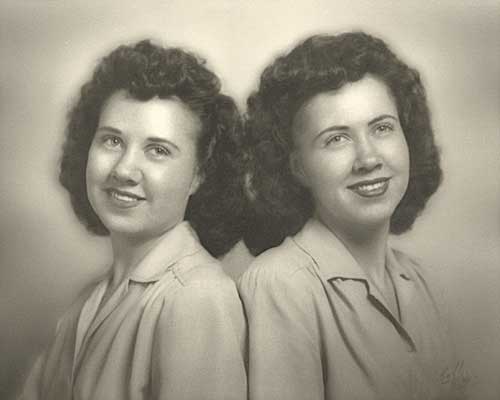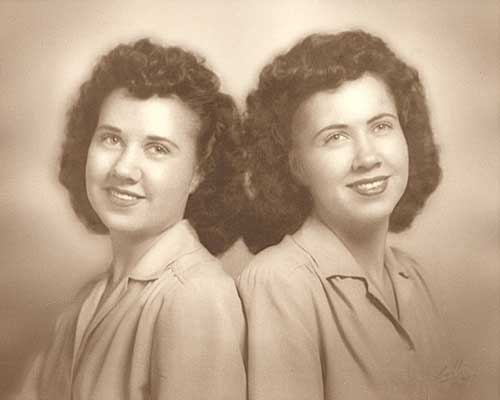Digital Imagery
Image Restoration

Saving Your Images
If you have pre-digial images on film or paper, by all means keep them. The actual film is the most important as it often contains more detail information than a print.
Converting you film images to digital images is common. However many commercial methods do not retain the quality of the original images because of a comparatively low pixwl count.
Ideally you want 300 pixels for every inch of print dimension. For example, if you want a quality 8"x10" print, your pixel dimensions should beat least 2,400 x 3,000 pixels.
Having your old or new images on a CD is convenient, but not necessarily Permanent.
Below is a commercial CD after just two years of "safe" storage.

In a recent (unscientific) test involving the recovery of several thousand images from CDs, even CDs with the visual appearance of being intact had an average accumulated loss of up to 2% per year (hence, a ten year old CD could have as much as 20% of the images irrecoverable).
The best assurance of having images intact over a long period of time is to make several copies and store them at various locations. Ideally, a dedicate hard drive exclusively for archiving and then making two sets of CD versions that you can give to relatives or friends. If these images are important to you, save at least three sets!
Image Formats
Currently, the most secure image format is a TIFF (Tagged Image File Format), however this format tends to use a lot of storage space.
JPEG (Joint Photographic Experts Group) is the most popular as it compresses a TIFF file down to a much smaller size. However, caution should be exersized as this is considered a "lossy" format, meaning a certain degree of quality is lost every time the image is opened and subsequently saved. When using a JPEG or JPG format, be sure to save at the highest quality (least compression).
Facts About Old and New Images
Did You Know?
Our Signature Reproductions Can Look Better Than The Originals —When They Were New!
The Old "Color" Images All of the typical old "color" images began as black & white, then toned, then hand painted. |
 |
How It Was Done Then after the image was dried and mounted onto rigid art board, it was then hand painted with the same type of oils used on other art masterpieces. |
|
 |
 |
At the time, color film was not refined enough to be a viable media, which made hand oiling images a common method for achieving a "color" image. As you might imagine, each step of the process was significantly labor intensive. One method for reducing costs was to bypass the brown tone step and directly hand oil the black and white. Although the results offered some degree of success, the black and white version had a cold, hard appearance, while the brown tone offered a warm, pleasing skin tone, especially in the shadow areas. |
|
 |
 |
Preservation in a Nutshell
COOL — Preferably, below 68F, ideally around freezing.
DRY — Preferably, about 20% to 30% humidity.
UNCONTAMINATED — Remove the print from any frames and matting — and any corrugated storage boxes! These materials are big contributors to the destruction of images!
NO GLASS — Contrary to popular belief, glass (in a frame) usually does much more harm than good. You're better of removing it. Consider, go to any museum, any where in the world. With rare exception, you will not find fine art, from any of the world's artist, framed under glass. And there is certainly a reason for this.
As with art prints, heirloom photographs, with few exceptions, are better off not being placed behind glass. Glass will pretty much seal the print in a contained environment, and the question becomes what are you sealing in, along with the print? This sealed environment can have harmful chemicals from the board the print is mounted to, the added backing of the frame, the glue of the frame, the resins of the wood, even the print itself, if it wasn't processed to rigid archival standards (and a lot of B&W prints do NOT meet those standards).
About the only time we recommend glass is if the print will be subject to a potentially adverse environment, such as over a fireplace (smoke & soot) or in a public area subject to fingerprints, soda spray, etc. If you do use glass, there is a special glass that's recommended, "Conservation Clear", which helps preserve the life of the print.
Brown Tone Prints
The soft distinct brown tone hues of the old images are certainly pleasing to the eye. However the original purpose of creating a brown tone print (from a black & white) was to extent the life of the image.
There were literally thousands of versions, each with a different ways to create a brown tone image, depending on the chemicals used, their concentration and how long they were processed.
Although there was a specific "Sepia" toner, 99% of what is commonly called "Sepia" prints are actually brown tones achieved by some other process.
Mounting & Matting
Quite often the most common cause of image destruction is the mounting and matting of prints!
If there is any acid what-so-ever, it will destroy your image!
Above all, AVOID mats and mounting boards that claim they are "acid-free"!
They say the product is "acid free" but that's only at the moment of processing, the acid returns to eat away at the image.
A dead give-away is to look at the edge of the mat board, if it is all discolored - as yellow - you're looking at acid contamination. The only boards that can be trusted are "RAG" boards.
When you package and store images make sure you use ARCHIVAL materials.
A good archival supplier is:
lightimpressionsdirect.com
An Excellent Photographic Reference
Henry Wilhelm and his research is considered the preeminent authority on photographic images and their preservation.
You can also download their free book which goes into great detail:
The Permanence and Care of Color Photographs:
Traditional and Digital Color Prints, Color Negatives, Slides, and Motion Pictures
by Henry Wilhelm with contributing author Carol Brower, Originally Published in 1993
(The download is almost 80 MB so plan on a wait.)
to provide you true, uncompromising image quality at competitive rates.
